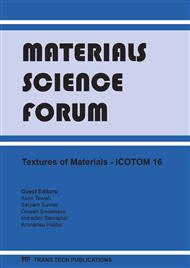p.866
p.872
p.876
p.880
p.884
p.888
p.892
p.896
p.900
Textural Evolution Evaluated by EBSD and XRD after Thermal Treatment in Ni-Ti Shape Memory Alloy
Abstract:
The Nickel-Titanium (Ni-Ti) alloys are the most attractive amongst shape memory alloys (SMA) due to their good functional properties coupled with high strength and good ductility. The transformation temperatures in Ni-Ti SMA can be altered by chemical composition and thermal and/or mechanical treatments adequate to obtain reversible martensitic transformation in one or more steps. The goal of the present work is to investigate the evolution of texture in Ni-Rich Ni-Ti (50.8at%Ni-Ti) SMA showing different phase transformation temperatures as a result of different thermal/mechanical history: straight-annealed (as-received condition) and subsequent thermal treatment at 500°C for 30 minutes in air. The microstructural and textural results were obtained by Electron Backscattering Diffraction on Scanning Electronic Microscopy (ESBD/SEM) and by X Ray Diffraction (XRD) at room temperature. Mechanical properties were measured by Vickers micro hardness tests at room temperature.
Info:
Periodical:
Pages:
884-887
Citation:
Online since:
December 2011
Keywords:
Price:
Сopyright:
© 2012 Trans Tech Publications Ltd. All Rights Reserved
Share:
Citation:


